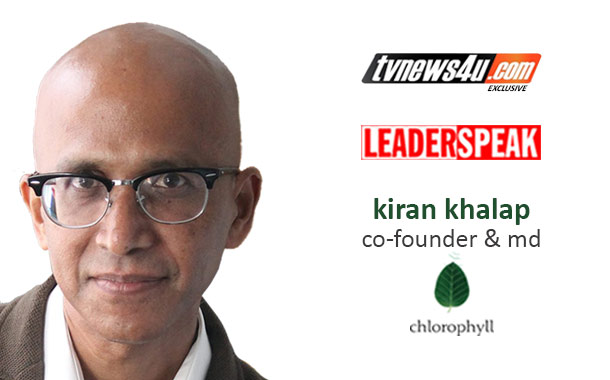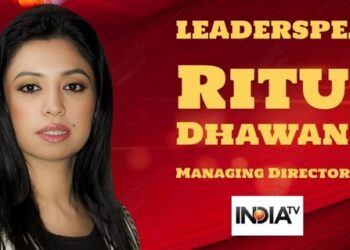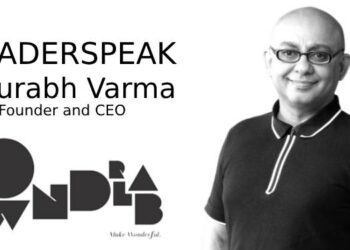By Yohan P Chawla
Kiran Khalap is one of India’s most respected Brand Consultants over a brilliant career of successful creative, strategic and innovation leadership, having co-founded and led with his team to enormous industry respect, India’s first end-to-end Brand Consultancy, chloropyll, through stellar work across more than 200 brands.
chloropyll entered its 20th year on 15th August 2018, and Kiran unveiled chlorophyll 3.0, which is empowered, as he has put it, ‘to deliver greater salience and value to clients in the digital age where Social Media has been causing subterranean shifts in the concept of brands and branding’.
I caught up with the man driven by ‘relentless learning’, on several topics. Kiran dwelt on the creative, strategic and purpose beliefs of chlorophyll and now chlorophyll 3.0, and shared the complete story of how the Brand consultancy was formed way back in 1999, its purpose and value systems and more enormously significant advice to marketers and brand custodians, and I came away even more impressed with and enlightened by the man whose self-descriptive Twitter profile reads: Day job brand consultant (chlorophyll.in); night job literary fiction writer; weekend rock climber; ‘perennial practitioner of conscious evolution.’. Also co-founder & md – chlorophyll.
Read on.
You were one of India’s most awarded young creative head. Did you always know that you would be headed towards entrepreneurship?
No. As an individual, I have never had ambitions. My favourite quote is, “Don’t push the river.” But lack of ambition should not be mistaken for lack of purpose: I always wanted to be extremely good at whatever I did, whether writing, creating brands or climbing rocks.
A creative employee or a creative owner of your own business – which gives you greater personal satisfaction?
Beautiful question. I feel creativity is deployed at three levels: problem-solution, self-expression and self-dissolution. Each level provides the same quality of satisfaction when done well.
Knowing that chlorophyll helped a brand look at itself differently and therefore achieve greater growth (problem-solution) is as satisfying as winning a short-story writing competition (Indo-UK Asian Age,1995) (self-expression) as is completing vipassana meditation course of ten days! (Self-dissolution).

How did chlorophyll actually come to be? As it enters its 20th year, tell us the complete story.
I was CEO and CCO (Chief Creative Officer) of Clarion Advertising when it was taken over by Bates in 1999. I had not enjoyed the culture of international network agencies, especially their hire-and-fire policies. My other option was joining an Indian ad agency, but there were no inspiring roles forthcoming.
So I asked Madan Bahal, co-founder of Adfactors PR, with whom Clarion had a partnership on IPO advertising, whether he would back me if I started a brand consultancy, a concept very new at that time, different from an ad agency or a design consultancy. He agreed without thinking twice. We wrote out the agreement on the back of a restaurant bill the size of a bus ticket. We were in a Udupi restaurant near Siddhi Vinayak Temple…
In June 1999, Madan made two important additions to the idea: one was to add a team of like-minded people, and two, to launch on a day of some significance to society at large. We chose 15th August, and had a launch party on 14th August 1999.

Anand Halve was then CEO of Quadrant, part of the WPP network. Even though we had never worked together, we had always dreamt of writing the GUT (Grand Unified Theory) of Advertising, just as Einstein wanted to create the GUT for the fundamental forces of nature. He, Praveen Tripathi and I had even written a research paper together, on the “Roots and Fruits of Brand Equity”.
Andy and I applied that dream of GUT to chlorophyll and created anthrop™, the brand model we still use. We have even added an algorithm to it.
Everything in chlorophyll has been handcrafted from scratch: every model, every process, every research technique, and every ideantity™ (http://brandideantity.com/). We haven’t borrowed a single idea from other brand thinkers, however established or famous.
I had also never worked with Gangadharan Menon and Nalesh Patil, award-winning Creative Directors working with McCann, but I had met them in the Creative Directors Club that I had created for the industry. Incidentally, the Creative Directors’ Club had a session for planning the future of Indian advertising, along with agency CEOs, under the tutorship of John Hegarty, the legendary Creative Director of BBH [Bartle BogleHegarty] in 1995.
I had great respect for Ganga and Nalesh’s minimalist work and they too jumped at the idea of creating something very different. Nalesh created over 60 ideantities™ for chlorophyll, which I guess is a world record.
Manjunath Hegde used to work with me in Clarion, and I knew that he had learnt the disciplines of brand planning when Chaitra became Leo Burnett India.
The last of the working team was Maria Pereira, who used to be my Executive Assistant in Clarion, and who has looked after me, in both my personal and professional life, since 1991!
MadanBahal and Rajesh Chaturvedi’s links to the media created the highest ever publicity for the launch of any new agency, which was at the Rooftop Rendezvous in Trident, Nariman Point. In fact all our birthdays are celebrated there!
One industry veteran — not to be named — who attended the launch said, ‘It won’t last: too many big egos in one small room.’
Another said, ‘It’s the same wine in a new bottle.’
I am glad chlorophyll did not live up to both predictions!
What kind of client do you like, and find the most supportive?
India is a pseudomature™ market, which means all levels of evolution of clients co-exist! Brands and branding are fuzzy concepts, so there is a lot of misunderstanding not only among clients, but also among branding experts. Irrespective of their level of understanding, we prefer clients who respect the idea of creating together, rather than either sitting in judgment or putting the entire onus of a solution on chlorophyll.
Please share three, four or five specific guidance pointers for clients – advice, if you will, that you believe will help them in their interaction with their consultants.
Not three or four, only one. Trust. If you don’t trust your consultant, don’t marry her!
And now, chlorophyll 3.0. So these added offerings indicate that spaces and gaps have appeared between the two ends for any brand consultancy to take cognizance of…? What made you aware of the scale of this fact?
We often got client feedback that they preferred chlorophyll to other consultants because there was no gap between brand definition and brand name, between brand definition and brand identity, between brand definition and brand packaging. We refer to these (brand name, identity and packaging) as the unchanging aspects of a brand. They do not change for decades. Advertising, collateral digital campaigns, events are changing aspects of a brand: they change every year.
For the past couple of years, the second feedback we were getting was: when chlorophyll hands over the brand to execution agencies — whether advertising agency, event agency, and digital agency — a gap appears between brand definition and its expression.
So we said, why not create these capabilities in-house, and help clients ‘Mind the Gap’ as it were?

What is your vision for, and what is chlorophyll promising to offer, through its upgraded version, as it were, which you call chlorophyll3.0?
Both the meaning of brands and the act of branding have been dramatically altered by social media. Stakeholders share ownership of brands, even if the legal ownership remains with the brand owner.
We all know that because of social media, Paid Media (mainstream advertising or digital advertising) does not give the same returns as Earned Media.
This is one reality that chlorophyll 3.0 responds to.
The chlorophyll innovation lab helps our clients get higher ROI through Earned Media. The innovation lab also helps create new products for our clients. And third, it creates internal or external platforms to nurture innovation.
Similarly, just as we have unique — and now tested over 200 brands! — models for brands, whether product, service or corporate brands, we needed to develop a definite model for brands using the exploding domain of digital. We have now achieved that with the help of Ashok Lalla, who is our Digital Business Advisor.
Tell us more about the catchily named ‘Mind The Gap’ offering?
Mind the Gap refers to the warning we see in all metro stations, whether New Delhi or New York. As I said, we had that feedback from clients, “Can’t you help us Mind the Gap between brand definition and brand execution?”
We needed to do a lot of spadework to own these capabilities. Either create in-house or create collaborations.
Thankfully, Chitresh Sinha, who has been a brand planner with chlorophyll for over eight years, wanted to create something new and own it himself (By the way, the chlorophyll model is the Zingerman’s model: see this video to understand what I mean:-))
So Chitreshbecame the CEO of the chlorophyll innovation lab. chlorophyll’s motto is ‘Practice before you preach.” So he invented a process for efficiency in innovation. A different process for creating a culture of innovation in an organization. A different process for creating a new product. A different process for creating ROI through Earned Media. And the lab achieves all this through collaboration: a three-way collaboration between innovation employees, client employees and hand-picked experts from the lab ecosystem of 80+ experts from around the globe, including MIT.
Anirban Mozumdar, our CEO, created the idea of collaborating with Ashok Lalla. That’s how we developed a model of digital business. We also bolstered our team with Hemant Morajkar, one of the finest thinkers on Social Media.
I had met the Meraki trio of co-founders (Ajit Ravindra, Namrata Parekh and Toshan Patil) when chlorophyll was a consultant to Procam, the people who changed a nation’s approach to fitness through their marathons. When the trio asked me to become an Independent Director on the Meraki Board, I grabbed the opportunity to learn from them, learn about the emerging trend of the sport becoming a tool for brand connect, like music has been.
That’s how the chlorophyll sports practice was born. Again, we collaborated to create a model that reflected a unique viewpoint.
chlorophyll 3.0 also implies longer relationships with clients: at least three years rather than just one year.
Are you implying that unless you can completely control and own implementation, there will be gaps? Is this a distrust of third parties, or a pure, honest conviction in your own passionate shepherding of your brand partner’s needs?
We are not implying anything. We are not foisting our model on to our client-partners. Clients know what they need. Our guess is smaller, entrepreneurial clients will prefer our model, compared to larger, traditional organizations with established relationships.

chlorophyll has nurtured over 200 brands. Which ones were the most satisfying to work with?
This is like asking, “Who is your favourite son?”:-)
We are incapable of taking short-cuts on our process, however small the assignment: we believe it is unfair, it is not doing justice to the faith reposed in us. (Read The First Lady of Media Buying, Meenakshi Menon, pays glowing tribute to Kiran Khalap)
While collaborating on each one of those 200 brands, we conducted research that in itself has created a huge bank of insights. It also helps us to track changes.
For example, we have defined over 12 real estate brands: each time, we detect changes in the consumer mind-set.
My greatest personal satisfaction is on a pro-bono assignment: Aadhaar. I was Chairman of ACSAC, the committee that worked with Nandan Nilekani and RS Sharma on defining brand Aadhaar, between March and May 2010. I cannot describe here how much we learnt: about India, about sheer scale, about technology.
I also work pro-bono for NGO brands Arpan, who work on abolishing child sexual abuse, and Protsahan in Delhi, who heal abused teenagers using art, theatre and music therapy.
chlorophyll hugely contributed to redefining CRY, India’s pioneer NGO, and we had a deep sense of satisfaction when our recommendations got implemented.
You have a unique system for eliciting innovative ideas. Tell us about it, the method with which instinct and training are put to use…
There are over 200 known techniques for idea generation!
The one you are referring to is called Synectics, which in the dictionary means “bringing into connection things of different nature” It is a close-ended — which means it gets over in 90 minutes flat — group brainstorming technique I was exposed to when I was seconded to Lintas Sydney in 1986. I have added my own two-bits to it, and have used it for clients as diverse as mutual funds and NGOs.
The parent consultancy having a separate innovation lab… does it sound like chlorophyll is saying, ‘We’ll charge you extra for innovative ideas’, do you think?
We are not charging extra for innovative ideas. Our fees are based on outputs. Some of the biggest assignments have involved only brand strategy as an output. Eg: Tata Motors Commercial Vehicles. Others involve brand strategy and brand name. Still, others involve brand strategy and brand name and brand ideantity™. Now, we are saying, “In case you want, we can also create Earned Media for you as an output. Or new products as an output. Or innovation culture as an output.
How do you see the role of an end-to-end Brand Consultancy change and evolve over the next 5 or 10 years of chlorophyll 3.0?
An obsession with learning: that’s how we have remained independent and thrived despite global brand consultancies entering India. My guess is we will have to evolve even more: just like innovation, we will create more verticals.
For example, Karl Sveiby, who created the idea of Knowledge Management, says that organisations compete in two markets: for consumers and for employees.
We already have proven models and processes for managing an Employer Brand. We managed Hindustan Unilever as an Employer Brand for eight long years, from 1999 to 2007, and learned a lot in that time. So Employer Branding can become a new vertical.
We have an online tool, named chlorophyll litmosi, for aligning corporate values and corporate behaviour.
We will revamp that and make it into another vertical.
What’s with all the lower case? Is it a quirk or a belief?
chlorophyll is always with a lower case c because it is our homage to our belief that as professionals we are all unequal, but as human beings we are all equal.
Anything else you’d like to share
I wish my friends Anand Halve and Nalesh Patil were alive to see this inflection point in chlorophyll’s life. I miss their genius, their sense of humour, their incredible humility.
Some links to our work that you can share are:
https://www.thelalit.com/press-kit/
















